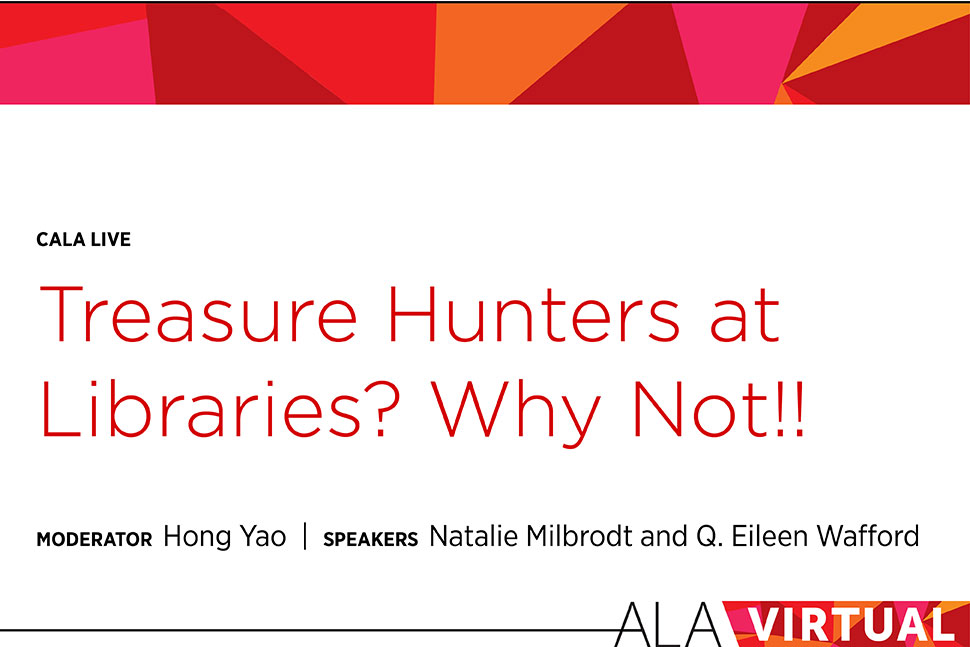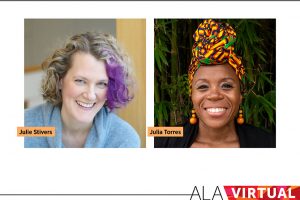
Curating and sharing information are basic library functions, yes. But programs that actively encourage patron agency in these activities can promote valuable discoveries—and give library users the thrill of a “treasure hunt.”
Hong Yao, president-elect of the Chinese American Librarians Association and director of technical services at Queens (N.Y.) Public Library, moderated a discussion on increasing engagement and investment in archives and community education during “Treasure Hunters at Libraries? Why Not!!,” a June 24 session at ALA Virtual 2020.
A map to the best information
Accurate, timely health information is definitely a treasure—one that can certainly take some digging, often through paid databases.
As research librarian at Northwestern University’s Galter Health Sciences Library in Chicago, Q. Eileen Wafford usually works directly with faculty, staff, students, and affiliated researchers. However, through the university’s outreach partners, she has been able to share training in evidence-based medicine (EBM) with communities in the Chicago area.
EBM combines clinical expertise, patient values, and quality research to make informed care decisions. In Wafford’s words, the approach allows her to “help people find the treasure that is the best available information for their health needs.” EBM training is a large part of her role within the university.
Wafford’s favorite program consists of a partnership with a suburban library and a resident facility for seniors. After local library staffers taught the seniors to use laptops, Wafford helped them learn how to use open databases and Google to find the best available health information. “By the end of the training, residents were able to find relevant health information, and they were so excited about it, too,” she said.
While different audiences in the community have different needs, “it’s so important to reuse content,” Wafford said. Since outreach isn’t her primary job, time is precious. “I’ve found it’s really important to keep open communication with partners to let them know what isn’t and what is possible” in a one-hour training session, she said.
Digging where you stand
The Queens Memory Project (QMP), a collaboration between Queens Public Library in New York and City University of New York’s Queens College, enters its 10th year this summer. This community archive uses a post-custodial approach, which holds that sharing skills as librarians and archivists is just as important as adding to the collection.
“It’s a way of democratizing local collecting and making sure our local history archives reflect the broad diversity we see in the borough of Queens,” said Natalie Milbrodt, director of the project and coordinator of the metadata services division at QPL.
The idea of “digging where you stand” informs QPM’s archiving efforts. “If we document our own communities,” Milbrodt said, “then we find treasures that are in our own experiences and in our own families and local history.”
The outreach strategies that have helped build engagement with QMP:
- Show and tell: Find a balance between asking the community for archival materials and sharing treasures from the existing collection. This has the benefit of letting users see the types of materials needed.
- Neighborhood ambassadors and artist partnerships: Artists and other creators can bring their work and existing audiences to the library’s collection, while the library provides archival services and other platforms that are difficult for individuals to maintain on their own.
- Pop-up events: Getting out of the library is a great way to spread the word about a program and reach new audiences.
- Digital partners: Get your content onto platforms beyond the library’s website. This includes social media as well as platforms like Urban Archive, a free app for self-guided walking tours. It’s good to have a tech partner with its own mechanisms for outreach, Milbrodt said.
- Remixes and mashups: Create curated displays and other entry points for oral history materials. QPM’s podcast highlights oral histories in its collections.
These strategies apply to more than just archiving. Whether the treasure is accurate health information or local history, said Milbrodt, “when you’re doing community-engaged librarianship, there are a lot of similarities in the work you’re doing, no matter what your subject is and no matter who your community is.”


